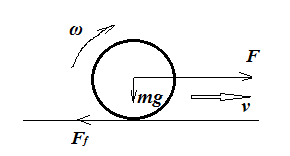I know that if a body is pure rolling with no acceleration then friction acting on it is zero. But what about if the CM has an acceleration? Then can we say that friction is present? Suppose that there is another force acting on the rolling body. Can there be a case such that there is no external force, but on a rough surface a body is pure rolling. Is it possible for the body to have A(cm) without another force? And can friction be non-zero in such a case? (I think that both these cases if they occur at all then occur together, but are they possible?)
-
1$\begingroup$ Where is your first sentence coming from? Is it a claim in a book (where?) or something that you have calculated? $\endgroup$– BowlOfRedCommented Nov 13, 2015 at 16:20
-
3$\begingroup$ @BowlOfRed: it is a correct statement. If both translational speed and angular speed are constant then there's no torque (provided by friction) needed. Whether the ball is actually rotating or not is even immaterial: $\omega=\text{constant}$ means no torque and no friction. $\endgroup$– GertCommented Nov 13, 2015 at 16:27
-
1$\begingroup$ @tmwilson26: 'generally considered' is a weasel term. A ball could be spinning at high $\omega$ and translating at $v$, without any friction involved. Similarly it could be purely sliding ($\omega=0$) without friction. As long as $\omega=\text{constant}$ no friction is needed. $\endgroup$– GertCommented Nov 13, 2015 at 16:30
-
1$\begingroup$ @tmwilson26: you could argue that it isn't rolling any more but why is that distinction important? From an equation of motion's POV only $\omega$ matters. $\endgroup$– GertCommented Nov 13, 2015 at 18:00
-
1$\begingroup$ @tmwilson26: to me it's very clear what he means: pure rolling is rolling without slipping. $\endgroup$– GertCommented Nov 13, 2015 at 18:05
1 Answer
Consider the diagram below of a ball on a horizontal surface:
Newton's Laws tell us that if no net force acts on the ball it will remain in a constant state of motion ($v=0$ or $v=\text{constant}$). Consequently, if no net torque acts on the ball its state of rotation will also remain constant ($\omega=0$ or $\omega=\text{constant}$).
Where friction does play a part, it is usually somewhat simplistically modelled as $F_f=\mu F_n$ with $\mu$ some friction coefficient and $F_n$ the normal force (here simply $mg$). But in the case of a ball rolling with constant $v$ and constant $\omega$ and no external force (say $F$) acting on it, this would lead to deceleration according to :
$$ma=-F_f$$
But then $F_f$ would also provide torque leading to angular acceleration according to:
$$I\dot{\omega}=F_f R,$$
with $I$ the inertial moment, $R$ the radius and $\dot{\omega}=\frac{d\omega}{dt}$ the angular acceleration.
This would be the case where you launch a ball with initial speed $v$ but no angular momentum ($\omega=0$) onto a surface that provides much friction: the ball would start spinning ($\dot{\omega} > 0$ but also start decelerating ($a < 0$) and translational kinetic energy would be converted to rotational kinetic energy. If the surface can provide enough friction that process would continue until $v=\omega R$: rolling without slipping.
To keep the ball moving without any deceleration we would have to supply an external force, so that:
$$F_f=F,$$
and $a=0$.
Critical coefficient of friction $\mu_c$:
Assume a ball with $v=0, \omega=0$ at $t=0$. We now apply a horizontal force $F$, so that $a>0$.
$$F_f=\mu F_n=\mu mg$$
$$I\dot{\omega}=F_fR=\mu mgR$$
After integration we get:
$$\omega=\mu\frac{mgR}{I}t$$
In that same amount of time the ball has also acquired translational speed:
$$F-F_f=ma$$
After integration we get:
$$v=\frac{F-\mu mg}{m}t$$
Without slipping we have:
$$v=\omega R$$
$$\frac{F-\mu mg}{m}t=\mu\frac{mgR^2}{I}t$$
Reworking and isolating $\mu$ we get:
$${\mu_c=\frac{FI}{mg(I+mR^2)}}$$
This is the minimum value for the coefficient of friction in order to achieve rolling without slipping when a horizontal force $F$ is applied.
-
1$\begingroup$ I figured that a case where acc, angular acc != 0 and friction also unequal to zero is not possible, because then pure rolling is not possible. So in short, if no net force then definitely friction has to be zero, and if net force, then friction is static. Is that right? $\endgroup$– ShodaiCommented Nov 14, 2015 at 5:19
-
$\begingroup$ @Shodai: that's correct. Of course there can also be a net force and no friction: if the friction coefficient is zero. In that case $\omega=0$ or $\omega=\text{constant}$ and $a \neq 0$. $\endgroup$– GertCommented Nov 14, 2015 at 14:07
-
$\begingroup$ @Gert:
and translational kinetic energy would be converted to rotational kinetic energy- you mean the energy is conserved even if there is friction? $\endgroup$– user36790Commented Jul 12, 2016 at 9:29 -
$\begingroup$ @MAFIA36790: part of the energy will be lost as friction energy (heat) but not all. I didn't claim full energy conservation. $\endgroup$– GertCommented Jul 12, 2016 at 13:07
-
$\begingroup$ @Gert: Got the point. $\endgroup$– user36790Commented Jul 12, 2016 at 13:13

